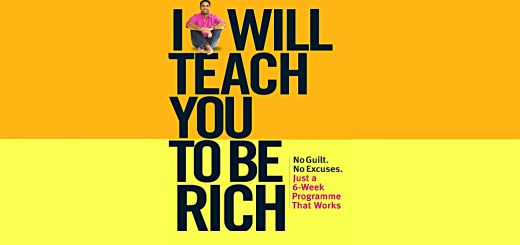I Will Teach You To Be Rich 3 – Budgeting and Automation

Today’s post is our third visit to a new book, the popular I Will Teach You To Be Rich by Ramit Sethi.
Contents
Budgeting
Chapter 4 of Ramit’s book is about budgeting, or as he calls it, “conscious spending”.
This isn’t about creating a fancy budget that you’ll have to maintain every day for the rest of your life. I hate budgeting.
In fact, Ramit thinks that nobody ever budgets.
Well, I do.
- Even fifteen years after reaching FI, and with a withdrawal rate of less than 1% pa, I still check my spending every month.
Now admittedly, if the top-line figure is within budget, I don’t drill down as far as I used to.
- But whenever I have a big-spending month, I want to know why.
And I enter the monthly figures into a spreadsheet and calculate annual totals each year.
- Which I would say is budgeting.
Conscious Spending
Ramit’s alternative to budgeting is a “Conscious Spending Plan”.
- This is an automated Pay Yourself First system which lets you spend the rest of your money guilt-free.
Outside of the plan, Ramit doesn’t care if you want a Caribbean holiday or if you want to skip £2.50 Cokes when out so that you can spend £15 on a movie.
- He doesn’t want his followers to confuse frugality – or its flipside of motivated spending – for “cheapness”.
He warns about being overly influenced by friends and family (or as we would call it, Keeping Up With The Joneses).
Frugality, quite simply, is about choosing the things you love enough to spend extravagantly on – and then cutting costs mercilessly on the things you don’t love.
It’s about making your own decisions about what’s important enough to spend a lot on.
His spending examples include shoes and partying.
Subscriptions
Ramit doesn’t like subscriptions.
- He recommends that you cancel everything and switch to a la carte payments for a couple of months, only switching back on the ones you can’t live without.
You also aren’t allowed to reinstate everything – you have to spend 10% less (and then the next time you do this, 25% less).
As well as feeling like overkill to me, this is a lot of work.
- Most services don’t make it easy for you to cancel.
Building your plan
A Conscious Spending Plan has four buckets:
- Fixed Costs (rent, utilities etc. – 50 – 60% of take-home)
- Investments (Pensions and ISAs -10%)
- Savings (bizarrely, Ramit includes vacations and gifts here – 5 – 10%) and
- Guilt-free Spending Money (20 – 35%).
So you do need to budget for your Fixed Costs – you are largely a price-taker here.
- Ramit suggests you build in 15% of slack here for those “unexpected” expenses which will occur in most months.
Then you subtract 10% of take-home for pensions and ISAs.
I can’t see much benefit in further splitting the 30 – 40% which remains into “major buckets”.
- You might as well drop straight down into the individual budget lines.
Savings seems to also include things like weddings and home deposits.
Optimisation
Once you have a plan, Ramit wants you to optimise it by focusing on the big wins.
- Try to reduce your largest expenses in order to free up money for the areas in which you are short.
For most of Ramit’s target audience, big wins revolve around eating out and drinking.
Ramit also recommends setting realistic (small and progressive) goals:
When a person goes from one extreme to another, the behavioral change rarely lasts.
Good habits are the way to go, not radical change.
- But he does recommend concrete goals – saving for something rather than just saving.
Envelope system
This is a budget system with fixed pots for categories like eating out, shopping, rent.
Once you spend the money for that month, that’s it: you can’t spend more.
In an emergency, you can steal from another envelope, but that’s it.
- Which sounds like plain old budgeting to me.
Making more money
Ramit suggests that people who try to save 10% for retirement but cant will need to work on increasing their income, in one of three ways:
- Ask for a raise
- Get a higher-paying job
- Do some freelance work (what personal finance types call a “side hustle”).
I would go further.
- Everyone on less than median income should focus on getting to more than the median income.
That effort will be more worthwhile in the long run than learning about index funds and tax-sheltered accounts.
Extra income
If you get a raise that you didn’t ask for, it’s very important not to spend it all on more expensive goods and services.
- This is known as lifestyle inflation, and avoiding it is key to financial success.
One-off windfalls (eg. birthday cash) matter less.
- Ramit spends half and saves half.
Automation
Chapter 5 is about automation and creating what Ramit calls an Automatic Money Flow.
- This is quite a grand title for a set of automatic payments (largely direct debits), but I suppose that he has to call it something.
Your money management must happen by default. You’ll be making your contributions to your savings and investing accounts grow passively – with no action required.
Ramit uses a concept called “The Next £100.”
Where will the next £100 you make go? Will it all go to your investment account? Will you allocate 10 percent to your savings account?
Of course, it needs to be allocated according to the Conscious Spending Plan.
- How many debits this takes will depend on how many separate accounts you are using.
But if we assume one for each of Ramit’s four high-level buckets (and that your salary arrives in the Fixed Costs account (current account), then you need at least three transfers:
- Investment, to SIPP and/or ISA
- Savings
- Guilt-Free Spending.
There is also a hidden transfer by your employer into your workplace pension.
- And of course, all your Fixed Costs will also be paid by direct debit.
Once again, I can’t see the benefits of this.
- You need to get your money into your investment accounts, but that needn’t happen every month.
My SIPP is full, but I have an ISA to contribute to each year, a couple of taxable investment accounts that I pay into more frequently, and each year I buy around six VCTs.
- So I probably make an investment transfer each month, but it’s a different one from each month to the next.
For me, the other three categories of spending can come out of the same account (albeit that many transactions will be via a credit card).
And that’s it for today.
- It’s been another easy day – we’ve only really looked at budgets and direct debits.
Up next are Experts and Asset Allocation.
- Until next time.














